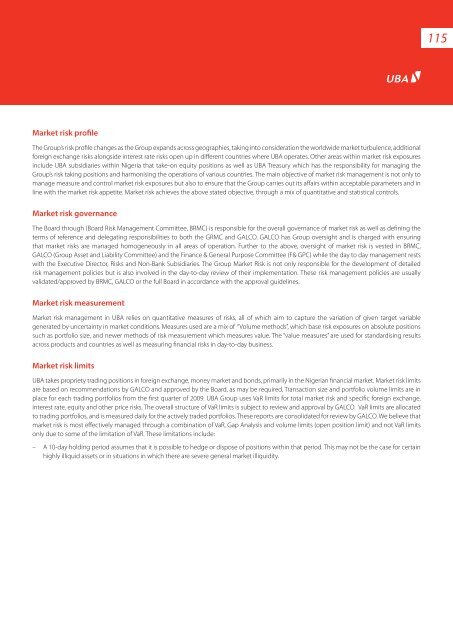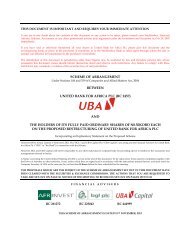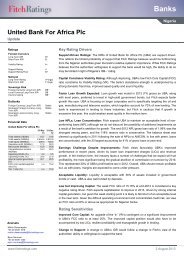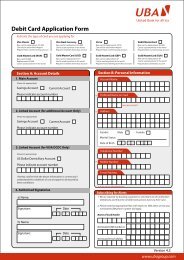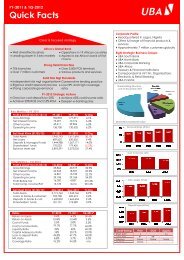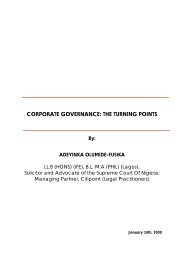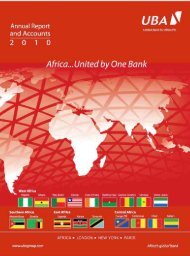2012 Annual Report & Financial Statements - UBA Plc
2012 Annual Report & Financial Statements - UBA Plc
2012 Annual Report & Financial Statements - UBA Plc
Create successful ePaper yourself
Turn your PDF publications into a flip-book with our unique Google optimized e-Paper software.
115<br />
Market risk profile<br />
The Group’s risk profile changes as the Group expands across geographies, taking into consideration the worldwide market turbulence, additional<br />
foreign exchange risks alongside interest rate risks open up in different countries where <strong>UBA</strong> operates. Other areas within market risk exposures<br />
include <strong>UBA</strong> subsidiaries within Nigeria that take-on equity positions as well as <strong>UBA</strong> Treasury which has the responsibility for managing the<br />
Group’s risk taking positions and harmonising the operations of various countries. The main objective of market risk management is not only to<br />
manage measure and control market risk exposures but also to ensure that the Group carries out its affairs within acceptable parameters and in<br />
line with the market risk appetite. Market risk achieves the above stated objective, through a mix of quantitative and statistical controls.<br />
Market risk governance<br />
The Board through (Board Risk Management Committee, BRMC) is responsible for the overall governance of market risk as well as defining the<br />
terms of reference and delegating responsibilities to both the GRMC and GALCO. GALCO has Group oversight and is charged with ensuring<br />
that market risks are managed homogeneously in all areas of operation. Further to the above, oversight of market risk is vested in BRMC,<br />
GALCO (Group Asset and Liability Committee) and the Finance & General Purpose Committee (F& GPC) while the day to day management rests<br />
with the Executive Director, Risks and Non-Bank Subsidiaries. The Group Market Risk is not only responsible for the development of detailed<br />
risk management policies but is also involved in the day-to-day review of their implementation. These risk management policies are usually<br />
validated/approved by BRMC, GALCO or the full Board in accordance with the approval guidelines.<br />
Market risk measurement<br />
Market risk management in <strong>UBA</strong> relies on quantitative measures of risks, all of which aim to capture the variation of given target variable<br />
generated by uncertainty in market conditions. Measures used are a mix of “Volume methods”, which base risk exposures on absolute positions<br />
such as portfolio size, and newer methods of risk measurement which measures value. The “value measures” are used for standardising results<br />
across products and countries as well as measuring financial risks in day-to-day business.<br />
Market risk limits<br />
<strong>UBA</strong> takes propriety trading positions in foreign exchange, money market and bonds, primarily in the Nigerian financial market. Market risk limits<br />
are based on recommendations by GALCO and approved by the Board, as may be required. Transaction size and portfolio volume limits are in<br />
place for each trading portfolios from the first quarter of 2009. <strong>UBA</strong> Group uses VaR limits for total market risk and specific foreign exchange,<br />
interest rate, equity and other price risks. The overall structure of VaR limits is subject to review and approval by GALCO. VaR limits are allocated<br />
to trading portfolios, and is measured daily for the actively traded portfolios. These reports are consolidated for review by GALCO. We believe that<br />
market risk is most effectively managed through a combination of VaR, Gap Analysis and volume limits (open position limit) and not VaR limits<br />
only due to some of the limitation of VaR. These limitations include:<br />
– A 10-day holding period assumes that it is possible to hedge or dispose of positions within that period. This may not be the case for certain<br />
highly illiquid assets or in situations in which there are severe general market illiquidity.


